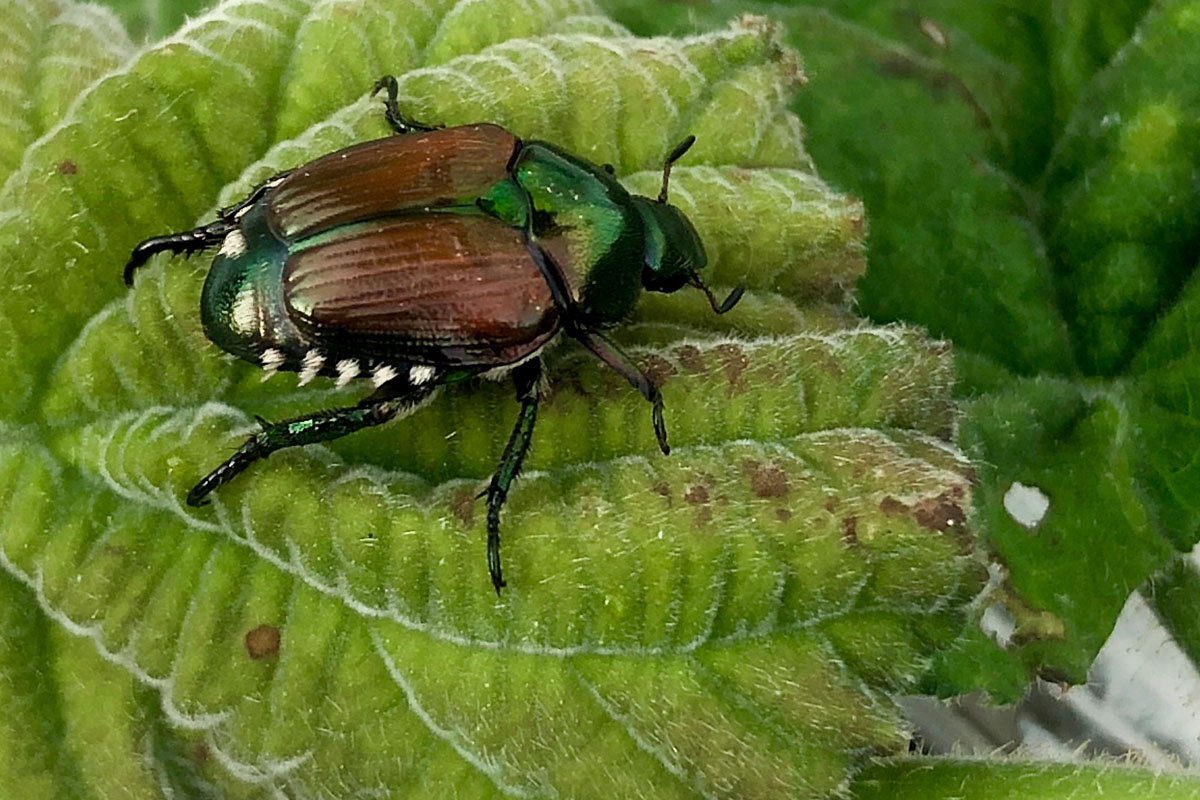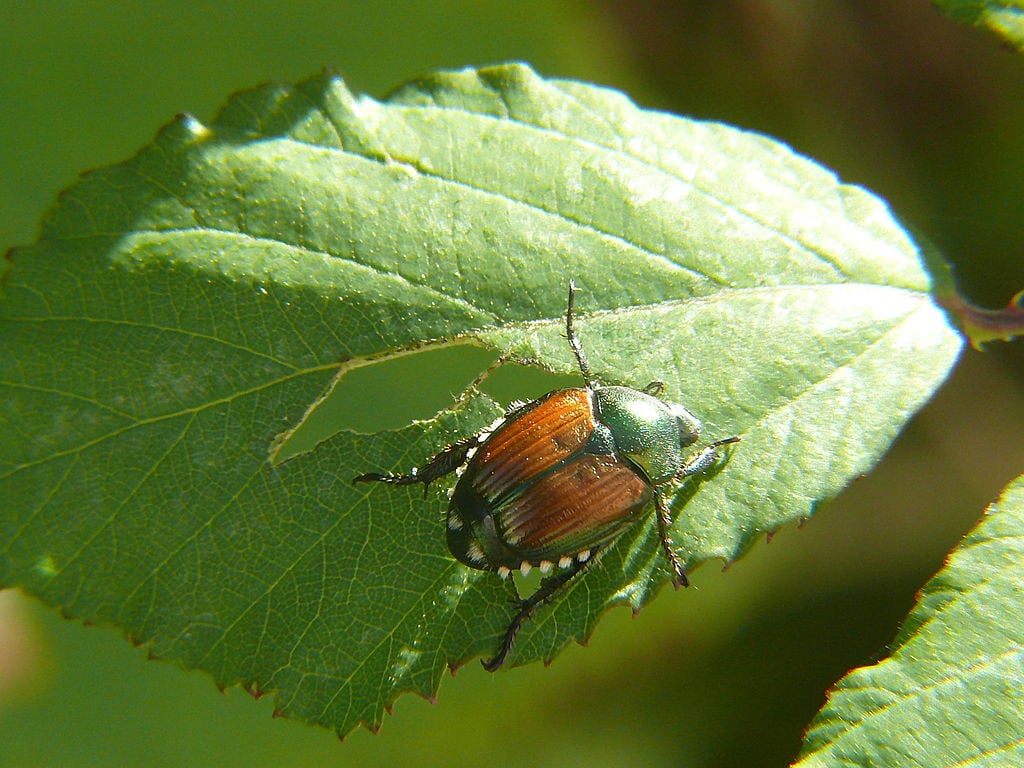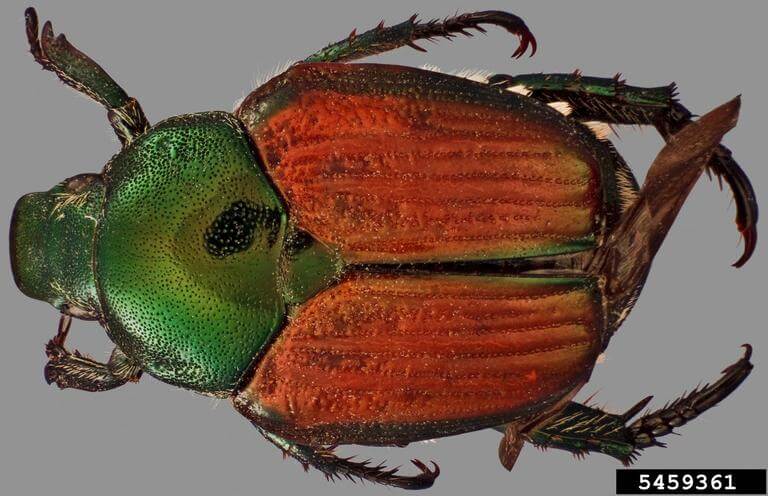japanese beetle life cycle wisconsin
Females leave ornamental plants where they feed and mate and burrow two to four inches into the soil under the turf in a suitable. The adults are most active in the afternoon in full sun.

Japanese Beetle Control The Good Earth Garden Center
The University of Wisconsin offers this information on Japanese Beetle life cycle which helped to.

. In mid-June or around 1000 growing degree day units adults begin emerging from the soil. Chris Williamson UW Turf and Ornamental Specialist The Japanese beetle Popillia japonica is considered the single most important turfgrass-infesting pest in the United States. To learn more about the Japanese beetle visit Wisconsin Horticulture.
University of Wisconsin Garden Facts Provided to you by. The Japanese beetle Popillia japonica is a significant pest of landscape trees and shrubs vegetable and fruit crops and turfgrass in the eastern United States. Japanese beetles have been reported this week feeding on corn silks and in one report kernels in southeastern Wisconsin.
Brown County Government Green Bay Wisconsin - providing Brown County news services and event information. In 2016 one of the surprises was the arrival of the two banded Japanese weevil Pseudocneorhinus bifasciatus often simply called the Japanese weevil. Appearance of adult the timing of oviposition and subsequent development have been shown to vary with latitude altitude and also from year to year Fleming 1972.
Welcome to Japanese Beetle Season. The adults are shiny black with white spots about 1 to 15 inches long with black and white horizontal stripes on their antennae. Japanese beetles occur in every state east of the.
Japanese beetle scouting and thresholds for corn and soybean are covered in this article. LaSalle Ave Room 2206 Barron WI 54812 537-6250. Revised June 14 2013.
In most parts of its range the Japanese beetle completes its life-cycle in one year but some populations in cooler climates may complete their development in two years Vittum 1986. Several native beetles found in Wisconsin have a similar appearance. The grub stage can further be sub-divided into three instar stages and is the longest of all stages in the life of a Japanese beetle.
Weevils themselves are technically a. Japanese beetles overwinter as late stage grubs within 5 inches of the soil surface in areas surrounding soybean or cornfields. Adults typically begin to emerge in late.
Japanese beetles cause different types of damage throughout their life cycle. During their summer feeding frenzy the female Japanese beetles are also tunneling into the ground to lay their eggs which will hatch during mid-summer. To learn more about non-native insects you can visit Wisconsin Department of Natural Resources.
As is typical in a given year Wisconsin sees a few new invasive species in the state each year. May 21 2021 - Japanese Beetles in the Landscape. To begin do not use the pheromone trapsbags.
If we have a period of above average rainfall the treatment will last a little shorter period of time below average rainfall and it will last longer. Japanese beetle larvae are similar to those of other white grub species such as MayJune beetles see University of Wisconsin Garden Facts XHT1240. Tim Jergenson Agricultural Agent Barron County UW-Extension 330 E.
University of Wisconsin Garden Facts XHT1062 Provided to you by. Japanese beetle can be devastating. In the heat of the summer it is the adult beetles who are emerging to feast on the leaves flowers and fruits of more than 300 plants species.
The Japanese Beetle treatment will kill the beetles that are present at the time of the treatment plus will kill the beetles landing on the treated areas for about 6 weeks after the treatment. Just about the time the rose chafer numbers are declining due to their life cycle the Japanese beetles show up in force this past mild winter allowed higher numbers of insects than usual to make it through to this year. A Japanese beetle grub.
What are the signs. See University of Wisconsin Garden Facts XHT1018 available at httpspddcwiscedu UW-Extension bulletins A3714 and. Published on July 23 2020 by vkast.
Japanese Beetles are the number one pest plaguing yards and gardens across Wisconsin right now. Life cycle Japanese beetles have only one life cycle per year. They have great details regarding life cycle control trapping and removing this pest from your gardens.
This non-native beetle is a turf and grass pest in the grub stage and the adults feed on a wide variety of fruits vegetables trees shrubs and flowers. Move over Popillia japonica theres a new Japanese beetle in town. 013 Japanese beetle likely to spread more 054 What to do with them 212 Life cycle of the Japanese beetle 230.
Japanese beetles have only one generation per year. The egg larva and pupa life cycle stages develop underground and unless soil is removed or dug into these life stages will not be seen. In southern New Jersey in 1916.
In mid-June or around 1000 growing degree day units adults begin emerging from the soil. Immediately thereafter females mate with males. Posted July 7 2020.
Adult females begin laying eggs soon after they emerge from the ground and mate in late-June. In mid-June as soon as they emerge adult females mate and begin laying eggs. Japanese Beetles are Making their Presence Known.
Established in Wisconsin in 1990s the Japanese beetle Popillia japonica is a voracious defoliator of many landscape and garden plantsRoses birches lindens grapes raspberries Norway maples beans apples plums crabapples elms beech asparagus and. Japanese Beetle Lab note Phil Pellitteri UW Madison Insect Diagnostic Lab Japanese beetle has become established in the southern 23rd s of Wisconsin. The WI DNR also has a link for reporting invasive sightings.
Japanese beetles typically show up in early July and by the number of. Liesch Director of the UW Madison Insect Diagnostics Lab will present everything homeowners need to know about this pest via YouTube Live on Monday July 27 from 200-300 pm. Their feeding weakens the plant in general and creates a.
Japanese beetles have only one generation per year. Article by Vijai Pandian UW Madison Extension and PJ Liesch UW Madison Entomology. Completing their one-year life cycle.
Japanese beetles have only one generation per year. It was first discovered in the US. For more information on Japanese beetle.
Observing Japanese beetles feeding on plants is quite common since the adult beetle feeds on about 300 species of trees shrubs ornamental and fruit trees in addition to vegetable crops. Beetles that were found in Boom Island State Park in 1991. Controlling Japanese beetle adults can be a real challenge but there are options for you.
Asian longhorned beetles Anoplophora glabripennis belong to a family of beetles that have exceptionally long antennae. This fact sheet on the Japanese beetle considered the single most important turf grass pest in the United States but also very destructive to various plants in the home and commercial garden covers the insects life cycle the damage it causes and the methods of control that are effective against it 3 pages.
How To Control Japanese Beetles Farm And Dairy

Brown County News All Departments Japanese Beetles In The Landscape

8 Facts You Should Know About Japanese Beetle Control Traps Grubs And Their Life Cycle

Japanese Beetle Soybean Pest Soybean Research Information Network Srin

How To Get Rid Of Japanese Beetles Planet Natural

Schedule My Japanese Beetle Treatment Today Rainbow Treecare

Information On Plants That Deter Japanese Beetles And Plants Japanese Beetles Avoid

Japanese Beetles 100 Years And Counting Insect Diagnostic Lab

Japanese Beetle Popillia Japonica

How To Get Rid Of Japanese Beetles Garden Design

Controlling The Japanese Beetle Door County Pulse

Managing Japanese Beetles In Vineyards Wisconsin Fruit

Japanese Beetle Wisconsin Vegetable Entomology

How To Get Rid Of Japanese Beetles In Your Yard

Japanese Beetle Control Get Rid Of Unwanted Pests In Milwaukee

Japanese Beetles Japanese Beetles Japanese Beetle Control Beetle


